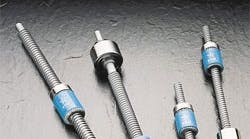Motors measuring 1/2-in. in diameter. Ballscrews with diameters less than 16 mm. X-Y positioning tables under 12 in. These miniature power transmission devices are typically found in medical systems and semiconductor manufacturing applications, with occasional miniature devices venturing into other applications. Well, the occasional venturing is showing signs of turning into frequent; manufacturers are noticing an increasing demand for small motor packages to do the work of larger (by comparison) motors. The demand comes from the need to reduce a product’s physical space requirements, yet deliver the same or more power of earlier product versions. However, manufacturers are also seeing these motors chosen because of their low weight yet relatively high power output, high speeds, and low inductance and electrical noise.
Low inductance has several benefits for computer-peripheral applications and systems in hostile environments suseptible to electrical noise, arching, or explosions. When the magnetic field in a motor with low inductance collapses, there is less chance of arching or spiking. Plus, in a computer application, crosstalk between channels is reduced or eliminated. Cross talk can cause a microprocessor to think it received an electrical pulse when it didn’t. Without a low inductance feature, motors in these applications would require isolation or shielding to prevent arching or the sending of false signals.
Many of these miniature step, PMDC, brush dc, and gearmotors can now be found in laser cutting systems, surface mount assembly systems, winding machines, robotic handling equipment, micrometer positioners, motorized potentiometers and screwdrivers, scales, aircraft actuators, computer peripherals, bar code scanners, and lab-top automation programs. Manufacturers also offer miniature ballscrews, positioning tables, and linear actuators.
In some of the available products, manufacturers use a nomenclature of Size X, with the X representing a number such as 5 or 30. This nomenclature refers to the outside diameter of the motor in 1/10-in. intervals. Thus, a Size 30 motor has an outside diameter of 3 in.
Size vs. capability
Ounce for ounce these devices deliver plenty of precision, accuracy, speed, and power output. For example, for power output, some motors with diam of less than 1 in. offer over 100 W. Other motors, such as a 48 Vdc motor, offer speeds to 100,000 rpm.
Miniature linear step motors are used in applications that require precise linear positioning. For some of these motors, resolution ranges from 0.008 to 0.000125 in. per full step.
Optical equipment, such as laser surface scanning equipment, need miniature ballscrews to execute small position changes and to avoid the effects of stickslip. This equipment typically uses ballscrews in sizes ranging from 5 to 12 mm. Some versions of these ballscrews offer load capacities from 200 to 2,670 N, with accuracies from 4 to 6 microns. A few miniature ballscrews have accuracies to 2 microns.
Cameras, in space or on Earth, use miniature motors to drive the zoom, iris, and focus functions as well as turn the camera in the pan and tilt axes. The motors in space cameras can be remotely controlled.
Miniature positioning tables are often used in measuring applications because of their low profiles, which allow more accurate measurements than larger tables.
Slightly different
To get the needed torque and power output and keep the size small, several miniature motor manufacturers use motor designs that differ from larger motors. Motors from Micro Mo Electronics Inc., Clearwater, Fla., for example, use a coreless motor (ironless core), a hollow rotor design, Figure 1. The rotor fits over a stationary magnet system. Only the copper coil moves, unlike larger motors where the whole coil and magnet system move. According to the company, these low inertia motors offer the fast response needed in pick and place machines, measuring devices, and avionic systems. The design offers high power to volume ratios — 38 mm diam motor can offer 100 W of power, approximately equivalent to a 1⁄8 hp motor.
Motors from Haydon Switch & Instrument Inc., Waterbury, Conn., use a simple rotor construction with alternate poles magnetized on the rotor. Some of the motors from this company use an enlarged rotor in combination with low inductance coils. The result is high torque to size ratios; for example a 2.2-in. diam motor produces 18 oz-in. of holding torque. Their step motors can be one or two-phase, and can be microstepped.
Some manufacturers follow a traditional motor design, but use different magnets and lower cost construction material, depending on the application. Most of these motors can operate in high temperature environments of 150 deg or more. Thermal protection, for any design, is typically through current limit recommendations or impedence protection.
For feedback, most manufacturers offer a range of miniature optical and magnetic encoders, ac and dc tachometers, and even resolvers. Some companies offer linedriver encoders for electrically noisy environments or where the distance between the encoder and the motor is long.
Other miniature components needed in a motor system include miniature brakes, controls, and servo systems with appropriate software.
Selection tips
As with larger motors and other power transmission components, physical size is one factor in the selection process. But the size of miniature PT components does not alter selection fundamentals. Manufacturers offer a few tips on properly applying selection fundamentals:
• Be sure to consider more than just the torque-speed curve, such as duty cycle, load, and other factors, when making a selection.
• Remember to consider thermal and environmental considerations.
• Properly drive the motor. For example, step rates too fast for a given motorload combination can cause problems that can be averted by ramping up to desired step rate.
• Set drive circuitry properly to get rated performance.
• For ballscrew selection, do not assume that electronic control and measurement systems can make up for failures of mechanical components.
• Be sure you know whether your application needs rolled ballscrews or ground ballscrews. (As ball size decreases, ground ballscrews provide proper operation of the ball circuit. Also, internal deflector type ball return systems allow balls as small as 0.6 mm to pass without jamming).
